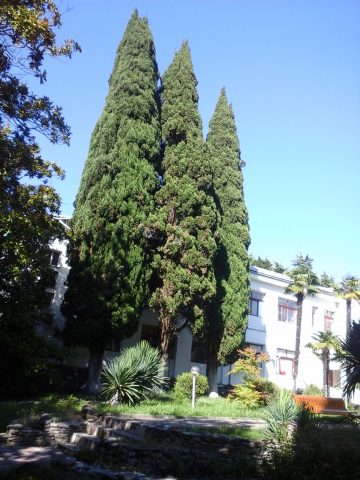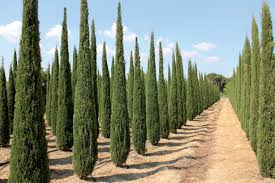Content
Pyramidal cypress is an evergreen, tall coniferous tree common on the Crimean coast. Belongs to the cypress family. The arrow-like crown, inherent in the pyramidal evergreen cypress, was bred by the Greeks of Ancient Greece. It does not occur in the wild in nature, the pyramidal cypress was bred by breeders of the Nikitsky Botanical Garden. The parent tree is an evergreen cypress, which differs from the pyramidal arrangement of branches, found in Northern Iran, Asia on the Mediterranean coast.
Description of the pyramidal cypress
Evergreen cypress is sometimes called Italian, because it is believed that it first appeared in the eastern Mediterranean, and from there it migrated to European regions.
Evergreen pyramidal cypress belongs to long-livers, its life span is calculated not in decades, but in several centuries. This coniferous tree grows very slowly, reaching a height of 20 to 40 m by the century of its existence. The greatest growth is observed at the beginning of the tree's life. In the first three years, the cypress grows up to 1-2 m in height. By the age of fifty, the growth falls, and the evergreen pyramidal cypress reaches its maximum growth point by the age of 100.
The trunk of an evergreen pyramidal cypress is upright, covered with dark gray or brown bark. Young trees have light brown bark, which darkens with age and turns brown.
The narrow pyramidal crown is formed by branches that fit tightly to the trunk and are directed vertically. Evergreen cypress leaves are scale-like, small. The needles are of an elongated rhombic shape. The needles are attached crosswise.
In the pyramidal evergreen cypress, rounded cones are formed that have a gray-brown color. The bumps resemble a ball in appearance. The scales covering the cone are provided with thorns. Seeds are formed inside the cones, the number of which varies from 20 to 30 pieces each.
Cones ripen in the second year after emergence. The seeds are small, provided with wings for better spreading over the territory. Seeds remain germinating for 5-6 years.
Evergreen pyramidal cypress refers to shade-tolerant and drought-resistant conifers. Prefers a mild, warm climate, but can survive temperatures as low as -20 ° C.
Evergreen pyramidal cypress tolerates a shaping haircut, therefore it is often used by landscape designers. Wood tolerates atmospheric pollution and cleans the air well from exhaust gases and dust.
Flowering begins at the end of March and continues through May. On the side branches, you can see bright yellow spikelets. The pollen falling on the needles changes its shade to dirty greenish.
The cypress aroma does not tolerate moths and wood-boring beetles, but the smell is considered curative for humans. In people suffering from lung pathologies, when inhaling the smell of cypress needles, an improvement is noted.
Evergreen cypress essential oil has bactericidal properties that can suppress the development of staphylococcus, tuberculosis and other pathogens.
Cones have astringent properties, so decoctions from them are prescribed for bleeding. And decoction baths are used for joint problems.
Pyramidal cypress in landscape design
Pyramidal cypress (pictured) has a beautiful crown shape, tolerates pruning well, therefore it is used for landscaping adjacent areas, parks, squares, alleys and even highways. Air pollution does not harm the evergreen ephedra.
Pyramidal cypress is often used in group plantings, favorably setting off other coniferous and deciduous trees and shrubs.
With a dense planting, the pyramidal cypress closes into a hedge. Group plantings are used to decorate the walls of buildings or fences.
Planting and caring for pyramidal cypress
Evergreen cypress belongs to light-loving plants, but for planting it is better to choose a place with periodic shading, otherwise the color of the needles may change, and the plant will lose its decorative effect. Choosing the right site and preparing it will help the tree to acclimatize.
Seedling and planting plot preparation
The soil for planting cypress trees should be light, sandy or sandy loam. Clay soil can lead to stagnant water and root rot. It is advisable to dig up the site before planting. This will help get rid of weeds and will saturate the soil with oxygen. In the process of digging, humus can be added.
It is better to purchase a seedling with a closed root system. The pyramidal cypress reacts poorly to damage to the root system, therefore, when transplanting, you should act carefully so as not to harm the seedling.
If the tree is purchased with open roots, it is immersed in warm water or a solution to improve root growth for several hours.
Landing rules
It should be noted that the pyramidal evergreen cypress is a drought-resistant tree, therefore it is important for it to have drainage in the hole. At the bottom of the dug planting pit, expanded clay or gravel is poured; broken brick and a layer of sand can be used.
The distance between adjacent trees depends on the required planting density. For large-sized plants, it is advisable to leave at least 2-2.5 m between the seedlings, so that with age they do not shade each other and do not interfere with the air circulation around the crown.
The size of the planting hole depends on the earthen clod on the roots. The approximate dimensions of the pit: diameter - 80-90 cm, depth - 60-70 cm.
On top of the drainage layer, a nutritious soil mixture is poured, consisting of the top layer of soil and coniferous soil. You can use a different composition:
- peat - 1 part;
- sod land - 1 part;
- leaf land - 2 parts;
- river sand - 1 part.
The components are mixed and poured into the well. A support peg is driven in, then the seedling is installed vertically and covered with the remaining soil mixture, carefully tamping each layer and pouring it with warm water.
After planting, the tree is tied up with soft ropes to a support post. This will prevent the barrel from breaking during windy weather.
Watering and feeding
Seedlings need regular soil moistening, but excessive watering is unacceptable. Mature trees do not need to be watered, they have enough seasonal rainfall. During the dry season, 2-3 waterings per season are allowed.
Water the seedlings with warm water, preferably in the evening after sunset or early in the morning. In the daytime, watering the seedlings is not recommended, since this leads to rapid evaporation of moisture.
To avoid yellowing of the needles, you can periodically spray the crown of young seedlings. Once every 14 days, epin can be added to the spraying water. For 10 liters of water, 0.5 mg of the drug will be required.
Cypress does not need feeding, but if the seedling is sick, you can try to feed it with special formulations containing magnesium.Organic feeding can harm cypress, so it is better to refuse to use mullein (manure).
Pruning
Formative pruning is best done in early spring as the plants will better tolerate the intervention. Shoots are pruned by no more than 1/3.
Broken branches can be pruned in the fall or spring. Sanitary pruning involves pruning damaged, frozen and diseased branches.
Preparing for winter
Preparatory measures are to mulch the trunk circle. Peat, sawdust, foliage or crushed needles are used as mulch.
Young trees need a secure crown cover. They are covered with burlap or agrofibre, and rewound with soft twine to avoid snow breakage of the branches.
Reproduction
Evergreen pyramidal cypress can be propagated in several ways: using seeds or by cuttings.
Seed propagation is long-term, therefore, they often resort to cuttings. It is advisable to use several cuttings at once for rooting, since the probability of rooting one cuttings is low. For the rapid emergence of roots, it is recommended to use special formulations - growth accelerators.
Diseases and pests
Evergreen pyramidal cypress is characterized by increased resistance to diseases and pests. Its wood contains a lot of fungicides that prevent the development of spores and fungi, the aroma of needles repels most insects.
Yellowing of the foliage most often indicates improper care. With very dry air, the crown begins to turn yellow, spraying is required. The yellowing may be due to the increased calcium content in the soil.
If the needles dry up and crumble, it means that the wrong site for planting has been chosen. An excessive amount of ultraviolet radiation can lead to drying out of the needles. It is advisable to transplant the tree in partial shade.
From insect pests on cypress, you can find scale insects and spider mites. To combat them, Aktellik, Aktara, Karbofos are used.
Conclusion
Pyramidal cypress is a tall tree used for landscaping adjacent areas, parks, squares, playgrounds. The seedling can be grown at home or purchased from a nursery.











